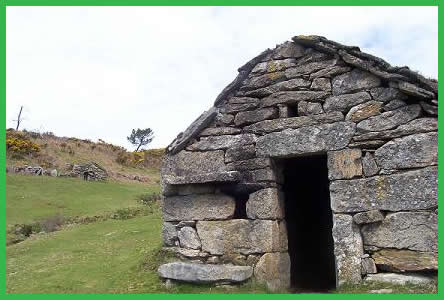
THE PLACE: LA SIERRA DEL SUIDO
The name is a reference to the family of omnivorous mammals, suidae, which includes pigs and wild boar. The Sierra del Suido forms a natural border between the provinces of Ourense and Pontevedra. It covers part of the municipalities of Avion and Beariz in Ourense and A Lama, Fornelos de Montes and Covelo in Pontevedra. The ridges or high plains make it difficult to mark the exact jurisdictional provincial boundaries, so this was long a source of legal disputes between the Counts of Rivadavia and those of Soutomaior, the overlords of the region. Various stages of the Santo Domingo way are taken as the current provincial boundary.
It covers an area of almost 200 square kilometres. Geologically, the smooth forms and evergreen peaks of the Suido are of pre Cambrian and Palaeozoic origin that makes it the oldest land in the Iberian Peninsula. It forms part of a mountain range that divides the Galician region in two. In the east there is Miño, in the south it opens into the Mondariz Valley, Monte Pedroso and the Faro de Avión; and to the north it continues into the Paraño with the Serra do Testeiro.
The average altitude is around 800 metres although there are a lot of areas over 900 metres and some peaks of 1000 metres .
THE GROUND PLAN
It is rectangular, with walls almost 1 metre thick because of the heavy load it has to support. The entrance is small as are the windows. what most catch the eye are the semicircular arches that can be found in most of them. The keystone of the arch and the voussoirs are the only parts of the construction that are carved. On the outside of the walls there are buttresses to prevent the arch from breaking under the weight of the gabled granite roof.
THE TECHNIQUE
The “chozos” were built in the Romanic style and date from the 13 th century. According to the villagers their origin is very different: before the Moors, from the time of the Celts… more than 1000 years ago. According to oral tradition they were already considered to be very old in the 19 th century. We can place their earliest date as being from the centuries of the expansion of the Romanic style (12 th and 13 th centuries). In Pena Corneira, in the Sierra de Avión massif, there is a small Romanic church, Santa Maria de Lamos (from the 11th or 12th centuries), which gives us a reference point that the Romanic style was already known in the area at that time.
USE OF THE CHOZOS
The chozo is a construction that gave shelter to the shepherds of the Suido Mountains when they took daily shifts looking after the cattle throughout the year. During the summer months they stayed out continually, with the neighbourly shifts being substituted for a full time shepherd. The work consisted of taking the cattle to the appropriate place at the appropriate time and avoiding danger. The old customs on dealing with cattle rustlers were severe with very harsh sentences as shown in the place known as “Pena Forcada” (Hanged man rock), which tells us of an unwritten law that cattle rustlers should be hanged. Around the main building there are a series of smaller ones, which were used to shelter the animals, and are called “cortillos”. Each family had their own.
